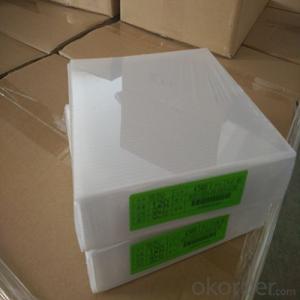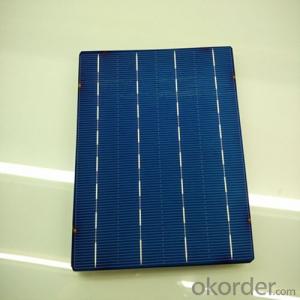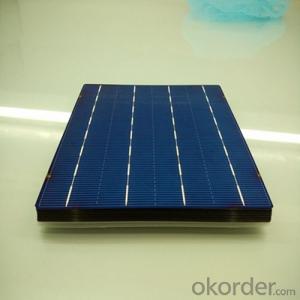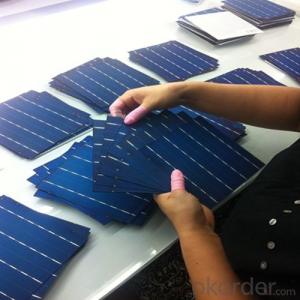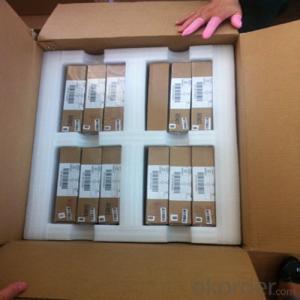Mono 156X156MM2 Solar Cells Made Low Price
- Loading Port:
- Shanghai
- Payment Terms:
- TT OR LC
- Min Order Qty:
- 4000 watt
- Supply Capability:
- 650000 watt/month
OKorder Service Pledge
OKorder Financial Service
You Might Also Like
Benefits of Solar Power:
Now is a great time to go solar and harvest the power of the sun. Here is our top ten list of the benefits to installing solar power:
When installed, solar energy is free – no resources are consumed
Help to lessen our dependence on heavily polluting coal power stations
Fossil fuels can't last forever, future generations will appreciate the effort
Characteristic of Mono 156X156MM2 Solar Cells
You are gaining energy independence - add battery backup power for even greater energy security
The cost of electricity is only going to rise – insure against that rising cost
Quality solar power and water adds value and appeal to your home
Specifications of Mono 156X156MM2 Solar Cells
Solar PV systems are easily upgraded in future - aim to make your house a net energy producer!
Solar panels offer a long lifetime of low maintenance service, maybe 30-40 years
Your friends will think you're great!
You'll feel great for doing your bit for the environment!
Mechanical data and design
Format | 156mm x 156mm±0.5mm |
Thickness | 210μm±40μm |
Front(-) | 1.5mm bus bar (silver),blue anti-reflection coating (silicon nitride) |
Back (+) | 2.5mm wide soldering pads (sliver) back surface field (aluminium) |
Temperature Coefficient of Cells
Voc. Temp.coef.%/K | -0.35% |
Isc. Temp.coef .%/K | +0.024%/K |
Pm.Temp.coef. %/K | -0.47%/K |
Electrical Characteristic
Effiency(%) | Pmpp(W) | Umpp(V) | Impp(A) | Uoc(V) | Isc(A) | FF(%) |
18.35 | 4.384 | 0.526 | 8.333 | 0.63 | 8.877 | 78.39% |
18.20 | 4.349 | 0.526 | 8.263 | 0.63 | 8.789 | 78.54% |
18.05 | 4.313 | 0.525 | 8.216 | 0.63 | 8.741 | 78.32% |
17.90 | 4.277 | 0.524 | 8.161 | 0.625 | 8.713 | 78.04% |
17.75 | 4.241 | 0.523 | 8.116 | 0.625 | 8.678 | 77.70% |
17.60 | 4.206 | 0.521 | 8.073 | 0.625 | 8.657 | 77.36% |
17.45 | 4.170 | 0.519 | 8.039 | 0.625 | 8.633 | 76.92% |
17.30 | 4.134 | 0.517 | 8.004 | 0.625 | 8.622 | 76.59% |
17.15 | 4.096 | 0.516 | 7.938 | 0.625 | 8.537 | 76.80% |
17.00 | 4.062 | 0.512 | 7.933 | 0.625 | 8.531 | 76.18% |
16.75 | 4.002 | 0.511 | 7.828 | 0.625 | 8.499 | 75.34% |
16.50 | 3.940 | 0.510 | 7.731 | 0.625 | 8.484 | 74.36% |
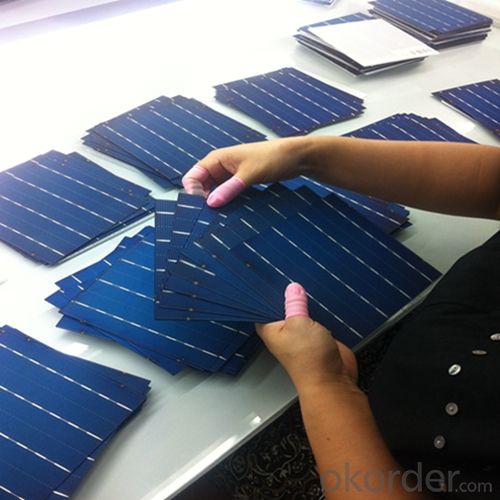

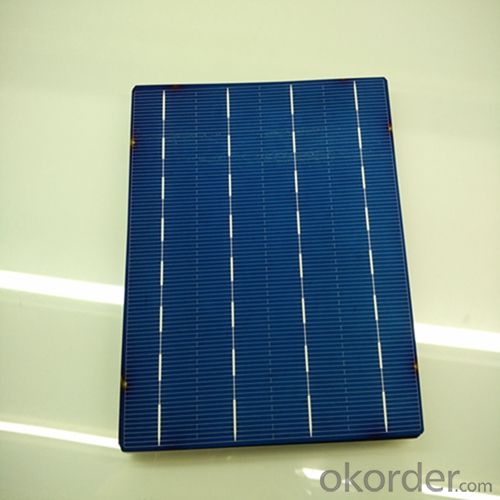
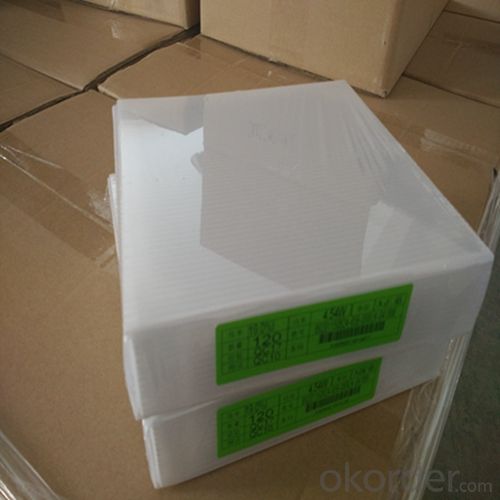

FAQ
Q: What price for each watt?
A: It depends on the quantity, delivery date and payment terms, generally Large Quantity and Low Price
Q: What is your size for each module? Can you tell me the Parameter of your module?
A: We have different series of panels in different output, both c-Si and a-Si. Please take the specification sheet for your reference.
Q: What is your size for each module? Can you tell me the Parameter of your module?
A: We have different series of panels in different output, both c-Si and a-Si. Please take the specification sheet for your reference.
- Q:Can solar cells be used for off-grid applications?
- Yes, solar cells can be used for off-grid applications. Solar cells, also known as photovoltaic (PV) cells, convert sunlight into electricity. This renewable energy source can be harnessed to power various off-grid applications such as remote homes, cabins, or even portable devices. By installing solar panels and storage batteries, off-grid systems can generate and store electricity for use when there is no access to a traditional power grid.
- Q:Can solar cells be used in remote areas?
- Yes, solar cells can be used in remote areas. Solar cells are a reliable and sustainable energy solution that can be installed in remote areas to generate electricity from sunlight, even in the absence of a traditional power grid. They provide an independent and cost-effective source of energy, making them ideal for powering remote communities, off-grid locations, and areas with limited access to electricity.
- Q:Can solar cells be integrated into building materials?
- Yes, solar cells can be integrated into building materials. Building-integrated photovoltaics (BIPV) is a growing trend where solar cells are embedded into roofing materials, windows, facades, and other building components. This integration allows for the generation of electricity while maintaining the aesthetics and functionality of the building.
- Q:Can solar cells be recycled?
- Yes, solar cells can be recycled. The process involves separating the different components, such as glass, metals, and semiconductors, and reusing or repurposing them for new solar cell production or other industries. Recycling solar cells helps reduce waste and environmental impact while also conserving valuable resources.
- Q:How much maintenance do solar cells require?
- Solar cells require very little maintenance. They are designed to be durable and require minimal attention once installed. Regular cleaning to remove dust and debris is recommended, and occasional inspections to ensure proper functioning are advisable. Other than that, solar cells are known for their long lifespan and low maintenance requirements.
- Q:What is the role of anti-islanding devices in solar cell systems?
- The role of anti-islanding devices in solar cell systems is to ensure the safety of utility workers by preventing the solar system from continuing to generate and supply electricity to the grid during a power outage. These devices detect when the grid connection is lost and immediately disconnect the solar system, preventing any potential harm or damage that could occur if electricity was still being fed into the grid.
- Q:What are the safety considerations when installing solar cells?
- Some key safety considerations when installing solar cells include ensuring proper electrical grounding and wiring to prevent electrical hazards, following relevant building codes and regulations, using appropriate personal protective equipment (PPE) such as gloves and safety goggles, and taking precautions to avoid falls or injuries while working at heights. It is also important to carefully handle and dispose of any hazardous materials used in the installation process, such as chemicals or heavy metals found in certain types of solar panels.
- Q:What is a monocrystalline Silicon Solar Cells?
- According to the wikipedia, the monocrystalline silicon (or "single-crystal silicon", "single-crystal Si", "mono c-Si", or just mono-Si) is the base material for silicon chips used in virtually all electronic equipment today. Mono-Si also serves as photovoltaic, light-absorbing material in the manufacture of solar cells.
- Q:Can solar cells be used in military vehicles or equipment?
- Yes, solar cells can be used in military vehicles or equipment. They provide a sustainable and reliable source of energy, reducing dependency on traditional fuel supplies and enhancing operational efficiency. Solar-powered systems can be integrated into various military applications such as portable power units, communication systems, surveillance equipment, and even hybrid electric vehicles, making them more environmentally friendly and cost-effective in the long run.
- Q:We are currently promoting our one of our solar cells seriers, which is the 156mmx156mm 6inch,2BB/3BB polycrystalline/multi solar cells,mono solar cell,made in Taiwan/Germany, please feel free to contact me if any interest.
- How long till it can be shipped? Because we are a solar construction company based in Taiwan, we need to make sure it can be shipped on time.
1. Manufacturer Overview |
|
|---|---|
| Location | |
| Year Established | |
| Annual Output Value | |
| Main Markets | |
| Company Certifications | |
2. Manufacturer Certificates |
|
|---|---|
| a) Certification Name | |
| Range | |
| Reference | |
| Validity Period | |
3. Manufacturer Capability |
|
|---|---|
| a)Trade Capacity | |
| Nearest Port | |
| Export Percentage | |
| No.of Employees in Trade Department | |
| Language Spoken: | |
| b)Factory Information | |
| Factory Size: | |
| No. of Production Lines | |
| Contract Manufacturing | |
| Product Price Range | |
Send your message to us
Mono 156X156MM2 Solar Cells Made Low Price
- Loading Port:
- Shanghai
- Payment Terms:
- TT OR LC
- Min Order Qty:
- 4000 watt
- Supply Capability:
- 650000 watt/month
OKorder Service Pledge
OKorder Financial Service
Similar products
New products
Hot products
Hot Searches
Related keywords
